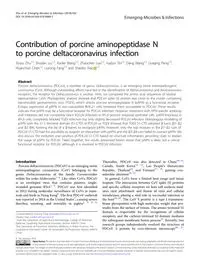
2018 Contribution of porcine aminopeptidase N to porcine deltacoronavirus infection PDF
Preview 2018 Contribution of porcine aminopeptidase N to porcine deltacoronavirus infection
Zhu et al. Emerging Microbes & Infections (2018) 7:65 DOI 10.1038/s41426-018-0068-3 Emerging Microbes & Infections A R T I C L E O p e n A c c e s s Contribution of porcine aminopeptidase N to porcine deltacoronavirus infection Xinyu Zhu1,2, Shudan Liu1,2, Xunlei Wang1,2, Zhaochen Luo1,2, Yuejun Shi1,2, Dang Wang1,2, Guiqing Peng1,2, Huanchun Chen1,2, Liurong Fang1,2 and Shaobo Xiao 1,2 Abstract Porcine deltacoronavirus (PDCoV), a member of genus Deltacoronavirus, is an emerging swine enteropathogenic coronavirus (CoV). Although outstanding efforts have led to the identification of Alphacoronavirus and Betacoronavirus receptors, the receptor for Deltacoronavirus is unclear. Here, we compared the amino acid sequences of several representative CoVs. Phylogenetic analysis showed that PDCoV spike (S) protein was close to the cluster containing transmissible gastroenteritis virus (TGEV), which utilizes porcine aminopeptidase N (pAPN) as a functional receptor. Ectopic expression of pAPN in non-susceptible BHK-21 cells rendered them susceptible to PDCoV. These results indicate that pAPN may be a functional receptor for PDCoV infection. However, treatment with APN-specific antibody and inhibitors did not completely block PDCoV infection in IPI-2I porcine intestinal epithelial cells. pAPN knockout in IPI-2I cells completely blocked TGEV infection but only slightly decreased PDCoV infection. Homologous modeling of pAPN with the S1 C-terminal domain (S1-CTD) of PDCoV or TGEV showed that TGEV S1-CTD adopted β-turns (β1–β2 and β3–β4), forming the tip of a β-barrel, to recognize pAPN. However, only the top residues in the β1–β2 turn of PDCoV S1-CTD had the possibility to support an interaction with pAPN, and the β3–β4 turn failed to contact pAPN. We also discuss the evolution and variation of PDCoV S1-CTD based on structure information, providing clues to explain the usage of pAPN by PDCoV. Taken together, the results presented herein reveal that pAPN is likely not a critical functional receptor for PDCoV, although it is involved in PDCoV infection. Introduction Porcine deltacoronavirus (PDCoV) is an emerging swine enteropathogenic coronavirus (CoV) belonging to the genus Deltacoronavirus of the family Coronaviridae within the order Nidovirales1–4. Like other CoVs, PDCoV is an enveloped virus that contains positive, single- stranded genomic RNA5, 6. PDCoV was first identified in 2012 during molecular surveillance of CoVs in mam- mals and birds in Hong Kong6. The first PDCoV outbreak was reported in 2014 in the United States7, causing severe diarrhea, vomiting, and mortality in piglets3, 4, 8, 9. Thereafter, PDCoV was also detected in China10–13, Canada, South Korea14, 15, Lao People’s Democratic Republic, Thailand16, and Vietnam17, 18, gaining con- siderable attention19–21. In general, CoVs have a limited host range and tissue tropism. The interaction between CoV spike (S) proteins and specific cellular receptors on host cell surfaces med- iates viral attachment and fusion of viral and cellular membranes, playing a vital role in successful infection in the host22–24. The CoV S protein is a type I transmem- brane glycoprotein with high molecular weight that pro- trudes from the surface of virions. The amino-terminal S1 domain is responsible for the recognition of cellular receptors, and the carboxy-terminal S2 domain mediates the subsequent membrane fusion process25. Recently, two research groups independently resolved the structure of PDCoV S protein by cryo-electron microscopy26, 27. © The Author(s) 2018 OpenAccessThisarticleislicensedunderaCreativeCommonsAttribution4.0InternationalLicense,whichpermitsuse,sharing,adaptation,distributionandreproduction in any medium or format, as long as you give appropriate credit to the original author(s) and the source, provide a link to the Creative Commons license, and indicate if changes were made. The images or other third party material in this article are included in the article’s Creative Commons license, unless indicated otherwise in a credit line to the material. If material is not included in the article’s Creative Commons license and your intended use is not permitted by statutory regulation or exceeds the permitted use, you will need to obtain permission directly from the copyright holder. To view a copy of this license, visit http://creativecommons.org/licenses/by/4.0/. Correspondence: Liurong Fang (
